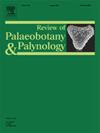Cupule-bearing cones of Jarudia (Doyleales) and associated leaves from the Early Cretaceous of the New Siberian Islands, Arctic Russia
IF 1.7
3区 地球科学
Q2 PALEONTOLOGY
引用次数: 0
Abstract
A new species of cupule-bearing seed cone assigned to Jarudia (Doyleales) is described from the Lower Cretaceous (Aptian–Albian) Balyktakh Formation of Kotelnyi Island in the New Siberian Islands. The new species, Jarudia borealis sp. nov. is an elongated, cylindrical seed cone consisting of a main axis with helically arranged, densely spaced bract-cupule axis complexes, each of which terminates in a single incurved cupule. Cupule-bearing stalks are thin proximally where they are fused with a narrow, elongated bract. Above, they are free from the bract, gradually widen toward the tip and are curved adaxially relative to the main axis. Each cupule is formed by the wide flattened distal part of the cupule stalk, one median and two lateral flaps, and is quadrangular in transverse section. The flattened cupule stalk and three flaps are fused at the apex of the cupule but are free toward the base. Micro-CT scans reveal that most cupules are empty, but maceration of remaining carbonaceous material produced pieces of the cupule cuticle, as well as fragments of the nucellar cuticle and megaspore membrane. Stomata, occasionally present in the outer epidermis of the cupules, are haplocheilic, with 5–8 subsidiary cells. The megaspore membrane is two layered comprising a foot layer and branched, interconnected bacula. The cupule-bearing cones of Jarudia borealis sp. nov. occur closely associated with numerous remains of linear leaves described as Phoenicopsis arcticus sp. nov., as well as rare leaf fragments of Pityophyllum sp. and Ginkgoites sp.
俄罗斯北极地区新西伯利亚群岛早白垩世的刺叶属植物的带对偶的球果及其伴生叶
描述了新西伯利亚群岛Kotelnyi岛下白垩世(Aptian-Albian) Balyktakh组Jarudia (Doyleales)的一新种。这个新种,Jarudia borealis sp. nov.是一个细长的圆柱形种子球果,由一个主轴和螺旋状排列的密距苞片-偶联轴组成,每个轴在单个弯曲的偶联中终止。具羽对的茎薄的近端在那里它们与一狭窄的,拉长的苞片融合。在上面,它们脱离苞片,逐渐向尖端加宽,并且相对于主轴向正面弯曲。每一羽节由羽节柄的宽而扁平的远端部、一个中瓣和两个侧瓣组成,横切面呈四角形。扁平的羽对柄和三个瓣在羽对顶端融合,但向基部自由。微ct扫描显示,大多数小泡是空的,但剩余的碳质物质浸渍产生了小泡角质层的碎片,以及珠心角质层和大孢子膜的碎片。偶有气孔,偶有于茎梗的外表皮,单倍体,有5-8个附属细胞。大孢子膜是两层的,包括一个足层和分枝的、相互连接的杆状体。北方Jarudia borealis sp. 11 .的有双苞的球果与许多被称为Phoenicopsis arcticus sp. nov.的线状叶片的遗迹以及Pityophyllum sp.和Ginkgoites sp.的罕见叶片碎片密切相关。
本文章由计算机程序翻译,如有差异,请以英文原文为准。
求助全文
约1分钟内获得全文
求助全文
来源期刊
CiteScore
3.50
自引率
21.10%
发文量
149
审稿时长
6 months
期刊介绍:
The Review of Palaeobotany and Palynology is an international journal for articles in all fields of palaeobotany and palynology dealing with all groups, ranging from marine palynomorphs to higher land plants. Original contributions and comprehensive review papers should appeal to an international audience. Typical topics include but are not restricted to systematics, evolution, palaeobiology, palaeoecology, biostratigraphy, biochronology, palaeoclimatology, paleogeography, taphonomy, palaeoenvironmental reconstructions, vegetation history, and practical applications of palaeobotany and palynology, e.g. in coal and petroleum geology and archaeology. The journal especially encourages the publication of articles in which palaeobotany and palynology are applied for solving fundamental geological and biological problems as well as innovative and interdisciplinary approaches.

 求助内容:
求助内容: 应助结果提醒方式:
应助结果提醒方式:


